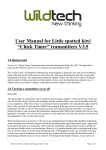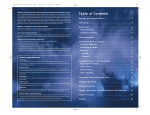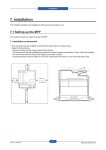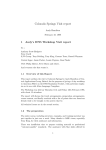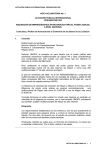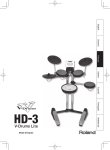Download User Manual for Kea “Egg Timer” and Juvenile version transmitters
Transcript
User Manual for Kea “Egg Timer” and Juvenile version transmitters V10.1 Summary Latest research on fonts and the effect on learning in New Scientist claims that learning and ingestion of information is enhanced by reading in difficult fonts because it switches the brain out of pattern recognition mode and in to letter by letter analysis mode performed in the „dorsal parietal cortex‟ an area linked with attention and memory. So here goes, lab rats, if you want the abbreviated version you‟re going to have to work for it. Otherwise you can read through all the guff in the most scientifically easy to read font. Ha haaa. Time setting is mandatory at turn on for all kea TXs. Set the time as the current time of day in hours past midnight. The duty cycle will then automatically sync to the predefined on and off times, but will not adjust for daylight saving, it’s not that cleaver. All variants output the software version and the time that has been set immediately after turn on, if you make a mistake turn the TX off and start again. Battery time remaining never forgets even if you turn the TX on and off multiple times. All TXs should achieve rated life assuming that the TX and all components are built to spec. “Talk back radio” can be used to check that a TX is going if a TX is turned on during a portion of the day when the TX would normally be “off” ie a long life juvenile TX fitted after 1700. In this case the TX will run for the first 10 minutes before falling in to the preset duty cycle off period. However during the off period the TX will chirp back a double pulse (beep beep) if a magnet is placed briefly over the reed switch ie for a shorter period of time than to turn the TX off. Manufacturing mode is a constant 80ppm with no outputs, switching to 48ppm if the hg switch is activated. 2013-01-13 User Manual Kea ET and Juv V10-1.doc Page 1 of 9 Egg Timer Rated life Duty cycle Pulse rates 112 weeks 0700 - 2300 Not incubating Incubating Mortality 20ppm 40ppm default state at turn on Double pulsing 30ppm time base Outputs at turn on 1. Software version. 2. Time set. 3. Activity Yesterday. Default value. 4. Activity 2 days ago. Default value. 5. Activity 3 days ago. Default value. 6. Activity 4 days ago. Default value. 7. Activity 5 days ago. Default value. 8. Activity 6 days ago. Default value. 9. Activity 7 days ago. Default value. 10. Long term mean. Default value. 11. Battery weeks of life remaining. Non mortality outputs every 20 minutes 1. Days since change of state. = software version at turn on 2. Duration of last incubation = time set at turn on 3. Activity Yesterday. 4. Activity 2 days ago. 5. Activity 3 days ago. 6. Activity 4 days ago. 7. Activity 5 days ago. 8. Activity 6 days ago. 9. Activity 7 days ago. 10. Long term mean. 11. Battery weeks of life remaining. Mortality outputs every 20 minutes 1. Days since change of state only. 2013-01-13 User Manual Kea ET and Juv V10-1.doc Page 2 of 9 Long life Juv Rated life Duty cycle Pulse rates 50 months 0700 - 1700 Alive Mortality 20ppm Double pulsing 30ppm time base Outputs at turn on accompanied by 40ppm background pulse rate for first 10 minutes 1. Software version. 2. The time set. 3. Battery weeks of life remaining Non mortality outputs every 20 minute 1. Battery weeks of life remaining Mortality outputs every 20 minutes 1. Days since death Short life Juv Rated life Duty cycle Pulse rates 124 weeks 0700 - 2100 Alive Mortality 30ppm Double pulsing 30ppm time base Outputs at turn on accompanied by 40ppm background pulse rate for first 10 minutes 1. Software version. 2. The time set. 3. Battery weeks of life remaining Non mortality outputs every 20 minute 1. Battery weeks of life remaining Mortality outputs every 20 minutes 1. Days since death 2013-01-13 User Manual Kea ET and Juv V10-1.doc Page 3 of 9 1.0 Background Version 10.1 “Egg Timer” transmitters have been developed specifically for Kea. The “Egg Timer” developed for Kea has been designed to detect the start and end of incubation. The transmitters output the number of days since the start or end of incubation. In addition there are a further 10 outputs, a description of these outputs is provided below. 2.0 Turning a transmitter on or off Over view The radio output of a transmitter can be turned on and off using a magnet. At the time of turn on the user must set the time of day in hours after midnight, this is compulsory. If the time of day is set correctly then the transmitter will automatically adjust itself so that it rolls over each 24 hour period at 0700 in the morning. If a time is not set the transmitter will not turn on. When the Egg Timer is turned on it will start in the incubating state. In theory this should be impossible, since transmitters are normally changed outside the breeding season and a brood patch and or egg would be noticed if the bird was incubating. After 8 days the transmitter will have built an activity profile for the bird and should switch to not incubating. However it is possible that the bird is incubating and in this case it will not switch out of the initial incubating state. Radio output duty cycle The radio output is duty cycled for all variants, in all states including mortality. The on period is from 0700 to 2300 in the case of an Egg Timer. Telling the transmitter what time of day in hours after midnight that it has been turned on (which in any case is compulsory for Kea TXs) will automatically set the duty cycle to run from 0700 to the predefined turn off time. But note the transmitters will not correct for day light saving, so a transmitter turned on in winter will run from 0800 to 0000 in the summer. Be very careful if you are turning a TX on at an atypical time of year and trying to adjust the turn on time you are setting by one hour, most people balls it up and end up going 1 hour the wrong way! The best way to check if what you plan to set is going to work or not is to view the problem from the perspective of the TX ie if you set a time of 2000 on an ET it will turn off in 3 hours time (when it thinks it is 2300), so count forward 3 hours from the current time and see if that is what you want. 2013-01-13 User Manual Kea ET and Juv V10-1.doc Page 4 of 9 Turn on and time setting A magnet is used to turn the transmitters on and off. When a magnet is placed in the correct location the transmitter will sound a tone (heard on a suitable receiver) for approximately 1 second. The magnet must be held in place until the continuous tone turns itself off, then moved away briefly from the transmitter and returned to the TX. The transmitter will then start to output pulses at a rate of one every 1.5 seconds. Each pulse represents one hour after midnight. Count all the pulses as heard and remove the magnet when the count gets to the current time in number of hours after midnight. Once the required number of pulses has been heard the magnet is permanently removed and the turn on sequence is complete. If the time of turn on was 3pm the time would be set as 15 hours after midnight, therefore requiring the magnet to be held in place until 15 pulses had been counted. The turn on sequence is aborted if the magnet is not held in place long enough for the continuous tone to turn off by itself or if the magnet is not returned fast enough to count one or more pulse to set the time. Setting the time correctly will also set the duty cycle to run between 0700 and 2100 in the case of a short life juvenile TX. In the event a transmitter is fitted at a time of day when the transmitter should be off the TX will run for 10 minutes after turn on before turning off for the remainder of the duty cycle off time. During the “off” portion of the day “talk back radio” can be used to confirm that the TX is running. “Talk back radio” is a feature where by the TX will chirp back a double pulse (beep beep) if a short duration (ie less than the 1 second required to turn it off) magnet pulse is applied to the reed switch. When the time set function is used a partial (non 24 hour) first day will be created, any activity that occurs during this partial day is ignored. Ie if a transmitter is turned on at 3pm the first partial day will be 17 hours long and the first full day will be from 0700 the next morning. If a transmitter is turned on at midnight then the time should be set as 24 hours after midnight since it is not possible to set zero hours after midnight. Turn off When a magnet is placed in the correct location the transmitter will sound a tone (heard on a suitable receiver) for approximately 1 second. The magnet must be held in place until the continuous tone turns itself off, then moved away permanently. If the magnet is not held in place for long enough for the tone to turn it‟s self off (ie „talk back radio feature) or not moved away fast enough after the tone has turned it‟s self off the turn off sequence is aborted, and the TX will stay “on”. Checking the time set after turn on To check the time that has been set, the user may listen to the outputs. Immediately after turn on the transmitter will output 10 pulses at a rate of 40 pulses per minute (one pulse every 1.5 seconds) the output sequence will then start and be transmitted to the user in the format described later, see earlier summary section for the order of the outputs. In the case of an “Egg Timer” the time of turn on is cleared at the end of the first partial day along with the software version number to zero, in the case of juvenile TXs these outputs disappear after the first 10 minutes. The zeroed days since change of state counter increments up one, at each full 24 hour period roll over and is reset in the normal way when the transmitter changes state to not incubating. If a mistake is made setting the time, turn the transmitter off and try again, it‟s fun you‟ll enjoy it. 2013-01-13 User Manual Kea ET and Juv V10-1.doc Page 5 of 9 3.0 Pulse rates See summary section above. 4.0 Outputs 4.1 Over view and explanations The alive, not incubating, incubating, and mortality pulse rates are broken every 20 minutes by a series of outputs as described in the summary section above. The transmitters will not start to give accurate activity information about the bird until at least 8 days after turn on, by which time the activity profile for the bird will have been confirmed. Days since change of state output The days since change of state outputs the number of days since the change of state to not incubating, incubating and mortality. Duration in days of last incubation state The number of days the previous incubation state lasted for. Activity outputs and long term mean Reports the time, in lots of 10 minute periods, the bird was considered to be active during the preceding 24 hour period. The 24 hr periods for the TX run from what the TX believes to be 0700 to 0700 every day. Battery life remaining output Is an estimate of the projected time remaining before the battery has the potential to go flat. It may be useful as a guide to help prioritise transmitter changes, or to assess the appropriate action should a bird be incubating near the end of the transmitters expected life. The transmitter will continually adjust the projected time remaining and is likely in the case of an “Egg Timer” to count down to zero faster or slower than projected depending on the cumulative periods the bird has incubated. Transmitters that spend some time in mortality will count down to zero in less than rated life because of the higher pulse rate. The transmitter will always remember how much time is remaining even if turned off and on multiple times and will therefore automatically correct for situations where transmitters have been left on by accident prior to fit. 2013-01-13 User Manual Kea ET and Juv V10-1.doc Page 6 of 9 4.2 Listening to the outputs Listening to the output sounds a lot worse on paper than it is in reality, so read to the end of the instructions to get the overall picture and then have a go. If you get stuck phone Wildtech for assistance on 027 672 4856 or 06 877 1563 Overall scheme During normal operation the day counter outputs start exactly every 20 minutes, based on the turn on time (even if the time of day has been set). i.e. If you turn on at 15:39:13, the next output sequence will start at 15:59:13 etc....There are 11 outputs (in the case of an “Egg Timer”), each output has two components tens and units (see detailed scheme below). Detailed scheme Using the first output for days since change of state as an example 7 Pulses Standard pulsing... (3sec gap) 4 Pulses ....... (3sec gap) .... (3sec gap) ...5 standard pulses before next output To interpret the days; 1. 2. 3. 4. 5. 6. Wait for the 3 second gap. Count the pulses. Wait for the three second gap Count the pulses. Wait for the three second gap. Write down the two numbers obtained. Following that five standard pulses (at either 30, 40 or 80ppm) will be heard before the next output comes in exactly the same format. 4.2 Recording the information When recording information in the field it is recommended that you write down what you hear and work out the answers when you get back to base. Using a Kea “Egg Timer” just after turn on with the time of turn on set to 1pm as an example the following should be recorded. 40ppm/12,3/3,5/5,2/5,2/5,2/5,2/5,2/5,2/5,2/5,2/13,4 40 is the pulse rate for incubating and the comma separated numbers are the tens and units for each output, all the activity numbers are pre-initialised values. After the first full 24 hour day the outputs should be quite different and more so after 8 days. 2013-01-13 User Manual Kea ET and Juv V10-1.doc Page 7 of 9 4.3 Working out the number of days The example above gives the following result, 12 pulses followed by 3 pulses for days since change of state. To obtain the true decimal values for the number of days it is necessary to subtract 2 from each individual number. This yields 10 and 1. The first number is the number of tens and the second number the number of units, therefore the final answer is 101 days since the start of incubation. But the number of days output immediately after turn on is relaying the software version. For Kea “Egg Timer” V10.1 transmitters this should be 12,3 i.e. Version 10.1. If a bird is incubating when the transmitter is fitted the “Egg Timer” will not switch out of the initial incubating state. If the time was set at the time of turn on (as it has to be in the case of kea TXs) then the software version will be cleared at the end of the first partial day as described earlier. In this case the timing can not be relied upon since the transmitter was not able to detect the start of incubation. Note The maximum number output is 256 days. In such a case the output for days will give 27 pulses followed by 8. After 256 days the counter roles over and restarts from 1. Only the most determined non breeders(at least for kiwi) are expected to test this feature, but you are quite likely to see it with kea I guess. 4.4 Working out the activity The example above gives the following result, 5 pulses followed by 2 pulses (the default activity for the transmitter after turn on). To obtain the decimal value for activity it is necessary to subtract 2 from each individual number. 5,2 with 2 subtracted from each number gives 3 then 0. 3 is the number of 10s and 0 is the number of units (i.e. the bird was active for 30 ten minute periods ie 5 hours). 4.5 Working out the battery time remaining The example above gives the following result, 13 pulses followed by 4 pulses. To obtain the true decimal values for the time remaining it is necessary to subtract 2 from each individual number. This yields 11 and 2. The first number is the number of tens and the second number the number of units, therefore the final answer is 112 weeks remaining because this is an “Egg Timer”. 2013-01-13 User Manual Kea ET and Juv V10-1.doc Page 8 of 9 5.0 Mortality The transmitters will also output the number of days since the start of mortality. Mortality “latches” and will be activated after 24 hours of zero movement of the TX. The timing output gives the number of days since the last movement. The predefined duty cycle is maintained in the mortality state. The time since death output will keep counting every day until the transmitter is turned off and restarted. The mortality pulse rate is double pulsing on a 30 pulses per minute time base which will sound very distinctive (beep beep.......beep beep). It should be noted that death may not necessarily result in zero movement of the transmitter, the carcase can be moved intermittently, presumably by scavengers for a number of days (and for kiwi in some cases in the region of 2 weeks). Consequently mortality cannot be relied upon as anything more than a guide to the maximum time since death. 5.1 Listening to the number output The output format in mortality is similar to that in normal operation the only difference is that all the pulses will sound fast. The start of the output sequence will be at the same time as normal. If you get stuck leave your transmitter going and phone Wildtech for assistance on 027 672 4856 or (06) 877 1563. When in mortality the days since change of state output will tell you how many days since mortality started. If the day counter was giving 2,9 then the time since death (or more accurately the time since the transmitter stopped moving) would be 7 days. Note The maximum number output is 256 days. In such a case the output for days would have given 27 pulses followed by 8. After 256 days the counter roles over and restarts from 1. However mortality pulse rates are approximately double the standard output pulse rates. Consequently it is unlikely the output will get to 256 days before the transmitters battery goes flat if the transmitter is in it’s last year of use. 6.0 Manufacturing mode If 80 ppm with the odd bit of 48 ppm thrown in at random is heard with no number outputs the transmitter is likely to have a hardware fault that (may go away) but is more likely to become chronic and result in transmitter failure. In such a case it is recommended that the transmitter be replaced immediately. However other forms of management may also be appropriate depending on the circumstances. Eg choosing to mark the nest of a known incubating bird rather than disturbing it so that it can be found in the event the transmitter fails may be a better overall outcome than tipping thre nest over. 2013-01-13 User Manual Kea ET and Juv V10-1.doc Page 9 of 9










